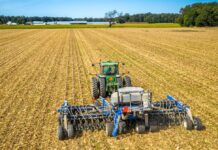(Original air date Jan. 22, 2023)
There is tension in America’s breadbasket with the push for green energy running up against rural residents trying to preserve a way of life. Now, some claim the stakes are even higher and could impact all of us, with a growing number of food farms being gobbled up by solar farms. Today, we’re off to Wisconsin where some rural landscapes are becoming a shiny sea of solar panels.
The following is a transcript of a report from “Full Measure with Sharyl Attkisson.” Watch the video by clicking the link at the end of the page.
This little windmill once powered a small water pump on the Polkinghorns’ Wisconsin dairy farm. Now, it’s surrounded by solar panels instead of cows.
Sharyl: Tell me about what time period the solar came — and did a company approach you, or did you hear about it?
Bill Polkinghorn: Yes, it was, oh, 2017 when they first approached, asked us, “Interested in solar?” And, no interest. But then they keep coming back to convince you. And all of a sudden, my wife and I decide, “You know, we’re not gonna live forever. When we die, what happens to the farm?”
So in 2018, Bill Polkinghorn and his wife said “yes” to solar. They’re getting paid two and a half times more to lease their land to this solar project than what a food farmer could pay.
Polkinghorn: There’s gonna be a good income. So, we decide, “Yep, this is it.”
Solar power is rising in a big way in Wisconsin, thanks partly to big federal incentives provided at taxpayer expense.
Brendan Conway: Yeah so we are here at our Badger Hollow Solar Park. It’s the largest, or one of the largest, solar parks east of the Mississippi, and actually east of the Rockies.
Brendan Conway is with WEC Energy Group, which owns six utilities companies.
Sharyl: Why is Wisconsin such a good place for these projects that are coming in?
Conway: Well, as a company, one of the things that we’ve made a real commitment to is reducing our carbon emissions, and one of the ways we’re doing that is, you know, generating power with clean energy.
The expansion of solar is also generating controversy, pitting farmers who are leasing their land to solar farms against those who want to keep it for agriculture.
Tara Vasby’s five-acre family homestead is nestled in a scenic spot that’s looked much the same for decades. Soon, it will be surrounded on three sides by a sea of sun soaking arrays.
Tara Vasby: The fence will be right there, and solar panels will be right behind it. So, literally 15-foot solar panels behind an eight-foot fence, 150 feet from my house.
Sharyl: Did you have any say in that?
Vasby: No. I continue to say, “Look, we’re destroying the environment in order to save it, and it doesn’t really make any sense.”
A 45-minute drive from Tara Vasby’s home, Elizabeth Groves lives on a small farm and is hoping to expand her micro beef operation.
Sharyl: What’s your concern about farmland being used for another purpose that can help people make quite a bit of money?
Elizabeth Groves: So, with what we’ve seen over the last two years with food shortages and supply chain issues and being told, you know, by our higher levels of government that that could possibly get worse with what’s happening in Ukraine, it just doesn’t seem like a good solution to take some of our most productive agricultural lands, not even just in Wisconsin but, you know, throughout the entire Midwest, and in the country, out of production.
Groves worries that leaders are losing sight of the long game. How less food farming stands to impact rural life for so many.
Groves: It’s going to affect implement dealers and seed companies and feed dealers. There’s gonna be less product, you know. And so that’s going to drive the prices up. And what is the trickle-down effect going to be in our communities?
The big city, Madison, Wisconsin, is where the solar projects go to get the green light from the Public Service Commission. Ellen Nowak is one of the commissioners.
Sharyl: And what has been the finding so far with the recent applications for the solar farms?
Ellen Nowak: So, so far, you know, it’s a mixed bag — well, we’ve approved all of them that I, at least that I have been here, the large ones.
Nowak says she personally favors a pause in the green energy rush to look at unintended consequences that could be coming. But she adds the commission doesn’t have grounds to deny projects that meet technical requirements.
Sharyl: You’re probably always going to have people unhappy with a decision.
Nowak: Yeah. It’s tough because you see small towns, you see people, neighbor against neighbor. But, at the end of the day for us, it’s a person’s right to lease their property as they wish. And as long as it’s compatible, I’m not one to judge that they can’t do that.
Sharyl (on-camera): Wisconsin already has more than 20 solar farms with at least a half dozen more large-scale projects on the way. With other states following suit, the battle between food farms and solar farms is bound to grow more heated.
Adding fuel to the fire, the Biden administration’s recent climate change law. It extended and expanded tax benefits given for solar systems — meaning more are on the way.
Rep. Tom Tiffany: The reason these wind and solar developers can offer $1,000 an acre is there’s these rich subsidies that are coming from the federal government, incentivizing this. It could be as much as $50,000 an acre that they can get via these subsidies from the federal government. That’s what’s driving this.
Congressman Tom Tiffany of Wisconsin is pushing for a bill that removes those subsidies for wind and solar projects if they’re put on food farms.
Tiffany: You can still build these facilities. You just can’t build it on productive agricultural land, as we’re seeing in the Midwest. And I think as we see food shortages looming around the world, that we need to be very cognizant of making sure that we don’t take productive agricultural land out of production. To me, that is the highest and most important public policy that we can implement is making sure that our people are fed.
Even Tiffany admits his bill stands little chance of passing. And Conway, with the Wisconsin utilities company, says worries about the food supply are unfounded.
Conway: You could produce 50% of the state’s energy needs using solar power, and it would use less than 1% of the farmland in the state.
Four years after he cut the deal to lease his land, Bill Polkinghorn says there have been a few snags with the solar company. But he professes no regrets for himself and no worries for America as more land is converted from farming food to farming green energy.
Sharyl: Are you concerned about farmland though being bought out or used up, or leased by, replaced by, solar and wind, on a big scale?
Polkinghorn: I’m not worried about our country ever going short of food. Maybe they won’t be able to export as much as they are. But it’s a very small percentage of land going into these projects. It’s not gonna hurt the total output.
Sharyl (on-camera): One Virginia county, where there are seven solar projects proposed or already built, the planning commission is proposing to limit solar farms to 2% of prime farm soils.
Watch story here.

Visit The Sharyl Attkisson Store today
Unique gifts for independent thinkers
Proceeds benefit independent journalism








